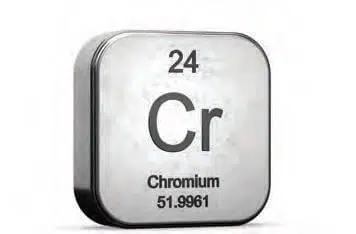Chromium is rapidly gaining momentum among nutritionists as a mineral that gets more interesting the more we understand about it. A relatively new arrival to the mineral scene, chromium has gained wide recognition for its effect on energy metabolism and its commensurate effect alleviating the disadvantages that stress places on our animals.
Evidence of multiple benefits
The first report evaluating the effects of chromium in ruminants was done 30 years ago, on insulin sensitivity in growing lambs. There is increasing evidence that chromium might have multiple benefits for ruminants, and positive responses to chromium supplementation seem to be related either to an apparent shifting of energy partitioning or an improvement in immunity and stress resistance.
Chromium is known to activate enzymes, maintain protein stability, and enhance carbohydrate metabolism, but the primary role of chromium is to potentiate the interaction between insulin and cell receptors, thereby allowing more glucose into the cell. The cell then converts this glucose to energy, which fuels protein synthesis, improves overall production, and has knock-on effects such as fertility support and ketosis reduction.

Dairy stressors
Today’s dairy cows experience considerable stress from many different sources. Calving, recovery, and peak lactation are all very stressful events. Infection, lameness, mastitis, and heat stress all activate immune responses and increase stress. Social and environmental stressors include long walking distances, mud, and group changes.
The transition window
The transition period, which runs from approximately 21 days before to 28 days after calving, has the greatest influence on the entire lactation. During this time, cows are under great physical, nutritional, psychosocial, and metabolic stress – a state that is reflected in altered hormone profiles and reduced immune function. The foetus accumulates chromium, especially during the last months of gestation, and serum chromium levels decline in the cow.
Chromium supplementation
All dairy cows experience a negative energy balance during the first few weeks after calving. During this time, animals require a large and rapid supply of glucose for milk lactose production. This sudden requirement results in lower plasma glucose and insulin. The ability of insulin to control glucose utilisation and partitioning determines milk production, fertility, and health status of cows. Supplementation of organic forms of chromium, from steam-up and into lactation, has been shown to be beneficial for dairy cows and can improve immune function, increase or maintain dry matter intake, maintain body weight after calving, and increase milk production. Most metabolic disorders in dairy cows occur at or shortly after parturition and represent a failure of the cow to adjust to the rapid onset and stress of high milk production. In addition, the incidences of many metabolic disorders increase with parity or age. Feeding and handling to minimise ketosis, fatty liver formation, hypoglycaemia, and other metabolic disorders are critical to cow health, productivity, reproduction, and longevity. Specific rations and strategies must be used, including possible supplementation with organic chromium.
The story of chromium continues
The story of chromium is, in many ways, the story of energy, insulin, and glucose. The story of energy to dairy cows is often a hard tale to tell. Energy is not only risky to supplement due to the negative effects of a high-starch diet, but also extremely difficult to balance on pastures. Chromium is proving itself to be a valuable tool in achieving the energy levels we need in our high-performing cows.
Alex Jenkins is a technical specialist in the ruminant team at Chemuniqué and holds a master's degree in animal science from the University of KwaZulu-Natal.










